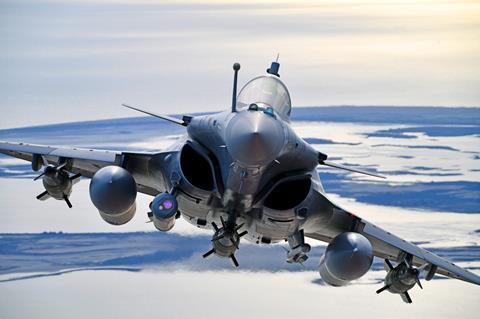Dassault Aviation continues to increase production of its Rafale fighter to meet soaring demand from the export market as total orders for the multirole type near the 500-unit mark.
The French airframer took in 60 orders for the Rafale last year – 42 tranche 5 jets for the French air force and 18 for Indonesia – an impressive total that came on the back of a blockbuster 2022 which saw combined commitments for 92 examples. A further 18 Rafales were added to its backlog by Indonesia in January this year.

But deliveries in 2023 barely scraped into double figures, with Dassault shipping just 13 Rafales, lower than the 15 units it guided for.
Dassault chief executive Eric Trappier says the goal is to deliver 20 aircraft this year as the company works towards “rate 2” – or production of two aircraft per month for an annual total of 22 units.
Some of its “upstream facilities” are already working at rate 3, but that increase will not be felt at its Merignac final assembly site near Bordeaux “for a year or two”, he said, presenting the company’s 2023 results on 6 March.
Progress has been “a great challenge” due to the state of the supply chain, but Trappier is confident that “we will go on to pace 3” and achieve an annual total of “more than 22 Rafales”.
As of 31 December 2023, total orders for the multi-role jet stood at 495 – 234 for France and 261 for export customers – while the undelivered backlog was 211 aircraft.
Trappier sees the production system as capable of coping with future increases should additional orders materialise.
“If we have to increase, we can increase further. While we cannot reach pace 20, we can go above pace three.”
Discussions continue with Saudi Arabia over a potential sale to the Middle Eastern country, which has a requirement for 54 aircraft.
Trappier says it also working with local companies in the Kingdom to “form partnerships with industry” in order to meet workshare requirements.
However, Dassault faces competition from incumbent suppliers Eurofighter and Boeing for the requirement with their respective Typhoon and F-15EX platforms.
Trappier has in the past been highly critical of Dassault’s relationship with Airbus Defence & Space on the Future Combat Air System programme the pair are developing alongside Indra for France, Germany and Spain.
But with work proceeding on the programme’s Phase 1B – led by Dassault – to develop a demonstrator for the manned New Generation Fighter (NGF), tensions appear to have eased; the relationship is now “quite normal”, he says.
Assuming a Phase 2 manufacturing contract can be signed off in 2026, the NGF demonstrator should fly in 2029.
Nonetheless, difficulties between the two firms are never far from the surface. A recent German defence ministry report blamed tensions between the pair for development delays to the Eurodrone programme, where Airbus is prime contractor.
“The main contractor Airbus D&S is trying to solve the existing problems regarding Dassault’s work comprehensively and promptly,” the report noted.
Trappier says “it is difficult with Airbus”, in part due to Dassault’s position as a subcontractor for the unmanned air vehicle’s flight controls and mission communication system.
It continues to wait for detailed specifications to be delivered, he says. “What was written in Germany is not the truth,” he suggests.


































